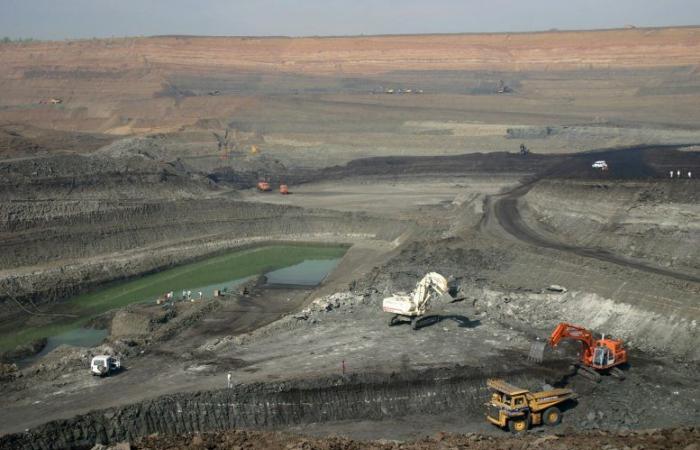Life reconstruction of Cambaytherium. Photo credit: Elaine Kasmer
These seminal finds of over 350 fossils, published in the prestigious Society of Vertebrate Paleontology Memoir Series, will become a point of reference for the origins of the horse, rhinoceros and tapir.
New research published today in the Journal of Vertebrate Paleontology describes a fossil family that sheds light on the origin of perissodactyls – the group of mammals that includes horses, rhinos, and tapirs. It offers insight into the controversial issue of where these ungulates evolved and concludes that they originated in or near what is now India.
With more than 350 new fossils, the 15-year study provides a nearly complete picture of the skeletal anatomy of the Cambaytherium – an extinct cousin of perissodactyls that lived on the Indian subcontinent nearly 55 million years ago.
Results include a sheep-sized animal with moderate walking ability and features that were between specialized perissodactyls and their more general mammalian precursors. Comparing its bones to many other living and extinct mammals, it was found that Cambaytherium represented a more primitive stage of evolution than any known perissodactyl that supported the group’s origin in or near India – before they dispersed to other continents than the land connection formed with Asia.
The team is searching for fossils from Cambaytherium at the Tadkeshwar Mine in Gujarat, India. Photo credit: Ken Rose
This new landmark article has been selected for publication as part of the Society of Vertebrate Paleontology’s prestigious memoir series, a special annual publication that provides a more in-depth analysis of key vertebrate fossils.
Cambaytherium, first described in 2005, is the most primitive member of an extinct group that branched out just before the development of the perissodactyls, providing scientists with unique clues as to the group’s ancient origins and evolution.
“The modern orders of artiodactyla (ungulate with straight toes), perissodactyla, and primates appeared abruptly in the northern hemisphere at the beginning of the Eocene, about 56 million years ago, but their geographic source has remained a mystery,” said Ken Rose, professor emeritus at Johns Hopkins University and lead author of the study.
Prof. Rose was intrigued by a new hypothesis suggesting that perissodactyls may have developed in isolation in India. Then India was an island continent drifting north, but later it collided with the Asian continent to form a continuous landmass.
Hot and dusty work in huge open-cast lignite mines in India provides clues as to the origin of perissodactyls. Photo credit: Ken Rose
“In 1990 Krause & Maas suggested that these orders could have developed in India during the migration north from Madagascar and would spread across the northern continents when India collided with Asia.”
Armed with this new hypothesis, Rose and colleagues received funding from the National Geographic Society to search India for rare fossil-bearing rocks of the correct age that could provide vital evidence of the origins of perissodactyls and other groups of mammals.
The first trip to Rajasthan in 2001 was unsuccessful: “Although we found only a few fishbones on this trip, our Indian colleague Rajendra Rana continued to explore brown coal mines in the south in the following year and came across the Vastan mine in Gujarat.”
This new mine turned out to be more promising. Rose added, “In 2004 our team returned to the mine, where our Belgian colleague Thierry Smith found the first mammalian fossils, including Cambaytherium.”
Encouraged, the team returned to the mines and, despite difficult conditions, collected fossilized bones from Cambaytherium and many other vertebrates.
“The heat, constant noise, and coal dust in the lignite mines were harsh – basically trying to work hundreds of feet near the bottom of open-pit lignite mines that are actively mined around the clock,” he said.
By accumulating many years of challenging field work, the team can finally solve a mystery about mammals. Despite the abundance of perissodactyls in the northern hemisphere, Cambaytherium suggests that the group likely evolved in isolation in or near India during the Paleocene (66-56 million years ago) before dispersing to other continents than land connection with Asia was formed.
Reference: “Anatomy, Relationships, and Paleobiology of Cambaytherium (Mammalia, Perissodactylamorpha, Anthracobunia) from Lower Eocene West India” by Kenneth D. Rose, Luke T. Holbrook, Kishor Kumar, Rajendra S. Rana, Heather E. Ahrens, Rachel H. Dunn, Annelise Folie, Katrina E. Jones and Thierry Smith, November 5, 2020, Journal of Vertebrate Paleontology.
DOI: 10.1080 / 02724634.2020.1761370
The Society of Vertebrate Paleontology Memoir’s series of memoirs is one of the few print publishing platforms for monographic treatments such as the one Rose and colleagues did for Cambaytherium. It is particularly noteworthy that this work uses a comprehensive digital modeling (CT / μCT) approach in which the data is accessible to researchers via Morphosource. The phylogenetic information used in the comprehensive study is accessible via the morpho bank.
Funding used to support field and laboratory research was provided by the National Geographic Society, the LSB Leakey Foundation, and the US National Science Foundation.
These were the details of the news Indian fossils support new hypotheses about the origin of horses, rhinos... for this day. We hope that we have succeeded by giving you the full details and information. To follow all our news, you can subscribe to the alerts system or to one of our different systems to provide you with all that is new.
It is also worth noting that the original news has been published and is available at de24.news and the editorial team at AlKhaleej Today has confirmed it and it has been modified, and it may have been completely transferred or quoted from it and you can read and follow this news from its main source.


